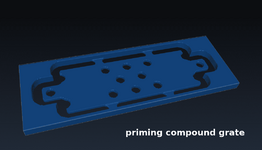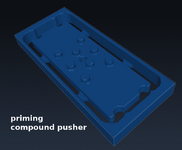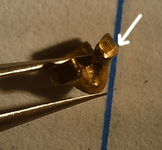- Messages
- 6,824
- Reactions
- 17,613
Not much here yet -- I'm just ending my thread hijack.
Previous posts:
How Federal charges primers:
Estimated thickness of priming compound layer: https://www.northwestfirearms.com/t...here-is-a-shortage.345280/page-5#post-2746998
Next steps: design loading plate, primer compound measuring grate, anvil aligner, anvil press
And some close up pictures of a Federal GM100M:



---------
just recreating the text of the OT post in the other thread in case it gets deleted -- one other such post with measurements got deleted.
A Federal small pistol primer assembly is 3.05 mm tall. The cup alone is 2.78 mm tall with the metal thickness being 0.4mm thick. That leaves a 2.38 mm space inside the cup to the brim.
Total anvil height is 2.32 mm but 0.27 mm of it extends beyond the rim of the cup (height of assembly minus height of cup) so the anvil extends 2.05 mm into the cup as measured from the rim. The tip of the anvil penetrates the priming compound but the three windows in the anvil do not have primer material extruding into them. There is a 0.27 mm gap from the tip of the anvil to the bottom inside of the cup, but there is more priming compound than.
The hard part is figuring out exactly how thick the priming compound. Based on this picture of an anvil with some priming compound residue on it, the green line is 54% as wide as the yellow line, and if the yellow line is total anvil height (2.32 mm), then the anvil penetrates 1.26 mm of priming compound. Adding this to the 0.27 mm untouched by the anvil, I'm guessing the priming compound layer is 1.53 mm.
If however I cut a plate to a 1.53mm thickness as the screen for measuring priming compund, I will over fill because of the volume of the cone shaped part of the anvil. Anyway, after doing some estimations on a closeup picture of the anvil, I estimate it takes up 18% of the volume of the primer compound space leaving me a primer compound thickness of 1.25 mm.
The inside diameter of the primer cup is 3.42 mm.

Previous posts:
How Federal charges primers:
Estimated thickness of priming compound layer: https://www.northwestfirearms.com/t...here-is-a-shortage.345280/page-5#post-2746998
Next steps: design loading plate, primer compound measuring grate, anvil aligner, anvil press
And some close up pictures of a Federal GM100M:
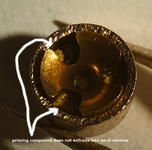
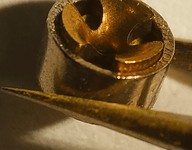

---------
just recreating the text of the OT post in the other thread in case it gets deleted -- one other such post with measurements got deleted.
A Federal small pistol primer assembly is 3.05 mm tall. The cup alone is 2.78 mm tall with the metal thickness being 0.4mm thick. That leaves a 2.38 mm space inside the cup to the brim.
Total anvil height is 2.32 mm but 0.27 mm of it extends beyond the rim of the cup (height of assembly minus height of cup) so the anvil extends 2.05 mm into the cup as measured from the rim. The tip of the anvil penetrates the priming compound but the three windows in the anvil do not have primer material extruding into them. There is a 0.27 mm gap from the tip of the anvil to the bottom inside of the cup, but there is more priming compound than.
The hard part is figuring out exactly how thick the priming compound. Based on this picture of an anvil with some priming compound residue on it, the green line is 54% as wide as the yellow line, and if the yellow line is total anvil height (2.32 mm), then the anvil penetrates 1.26 mm of priming compound. Adding this to the 0.27 mm untouched by the anvil, I'm guessing the priming compound layer is 1.53 mm.
If however I cut a plate to a 1.53mm thickness as the screen for measuring priming compund, I will over fill because of the volume of the cone shaped part of the anvil. Anyway, after doing some estimations on a closeup picture of the anvil, I estimate it takes up 18% of the volume of the primer compound space leaving me a primer compound thickness of 1.25 mm.
The inside diameter of the primer cup is 3.42 mm.
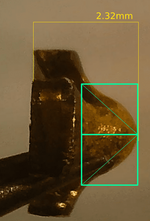
Last Edited:







